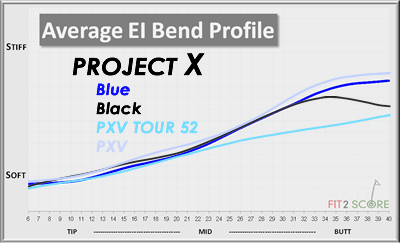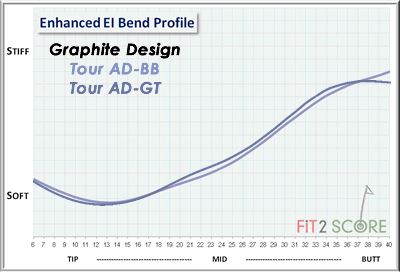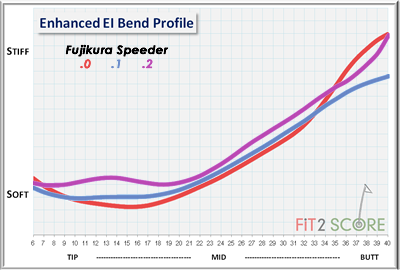To continue reading this section of the review, you must be registered at a higher level membership.
Russ
Fujikura Motore Speeder Golf Shaft Review
FUJIKURA MOTORE SPEEDER DRIVER SHAFT
By Kirk James & Mark Vallier, A Golf Digest America’s 100 Best Clubfitter
MK Golf Technologies,San Antonio, Texas
Fujikura shafts continue to dominate the PGA Tour and Champions Tour with wins and number of shafts in play. The original Speeder earned the reputation as the “winningest shaft on tour” back in 2000, and Fujikura has not lost momentum since. The latest version of the Speeder – the Motore Speeder – continues the tradition of the original. The Motore Speeder comes in three “regular versions” (the VC .0, the VC .1, and the VC .2), and two “Tour Spec versions” (the VC .2TS and the VC .3TS). The VC .0 and VC .1 versions are offered in mid 50, 60 and 70 gram models. The VC .2, VC .2TS and VC .3TS versions are offered in mid 60 and 70 gram models. Generally speaking, as the numbers of the models increase, the launch and the spin of the shaft decrease. In other words, if all other variables are equal, the VC 5.0 will launch higher and spin more than the VC 5.1, and so on up through the line.
This EI Bend Profile chart clearly shows the differences in the three versions of the “regular” Speeder shafts. It has been our experience fitting these shafts that the VC.0 model is very stable and somewhat stiff in the hands (ie, the butt of the shaft) but has a relatively soft and active tip. The EI bend profile clearly confirms these observations to be correct. The VC.1 model has shown through experience to be somewhat softer in the hands, but slightly stiffer in lower mid/tip of the shaft than the VC.0. Likewise, the VC.2 model through experience seems closer to the feel of the VC.0 in the butt of the shaft, but significantly stiffer than than either the VC.0 or VC.1 in the lower mid and tip sections of the shaft, producing a lower launch and usually lower spin.
Fujikura Fitting Advisor
DevotedGolfer.tv editor Russ Ryden got to talk to Pat McCoy, Director of Tour Operations for Fujikura Composites about the the online fitting application developed by Fujikura to help the golfer find his fit from the many Fujikura shafts available. Pat has been fitting tour professionals for about 20 years. His perspective on golf club fitting comes from years of experience fitting the best players with some of the best shafts in the business.
To continue reading this section of the review, you must be registered at a higher level membership.
Russ
---
Nippon N.S.Pro Regio Formula Driver Shaft Review
NIPPON N.S.PRO Regio Formula
By Russ Ryden, A Golf Digest America’s 100 Best Clubfitter
Fit2Score, Dallas Fort Worth, Texas
The Nippon N.S.Pro MODUS3 Tour 120 irons shaft has become one of Nippon’s best sellers. The design is unique. And that design has now been used in a driver shaft. It is different enough that I cannot comment without testing it. My first look was with a model that was too soft. Stay tuned, there will be more testing soon.
The closest Ei match is the Graphite Design TourAD DI and the Mitsubishi Series G Ultralight. The Modus Tour 120 profile was uniquely different and has become one of my favorite shafts for low single digit handicap players. When and where it fits, dispersion tightens. The graphic below may look a little bumpy. These are single shafts profiles, not the averages typically seen in other reviews. The radial quality of this shaft is excellent, The consistency of the bend profile signatures are as good as it gets.
The technical discussion, measurements and testing results are available only to registered readers
Project X Driver Shaft Review
True Temper Project X & Project X PXv Driver Shafts
By Russ Ryden, A Golf Digest America’s 100 Best Clubfitter
Fit2Score, Dallas Fort Worth, Texas
The Project X brand name came from Royal Precision. Royal Precision, an iron shaft only company, was acquired by True Temper in 2006. The Project X brand name was part of that purchase. Project X branded driver shafts appeared soon after that purchase. They use the same stiffness designation as the Project X irons shafts, numbers, rather than letters. The 5.0, 5.5, 6.0, 6.5 & 7.0 numbers designate stiffness. The original numbering scheme was formula based and came from frequency and length. The numbering system on the Project X driver shafts, like all other driver shaft stiffness designations I have seen are based on both weight and stiffness. A heavier 6.0 shaft will also be a stiffer 6,0 shaft.
 I looked at four versions of the Project X driver shaft, the original Blue, the lighter weight Black, the newer, PXV Tour52 and the PXV.
I looked at four versions of the Project X driver shaft, the original Blue, the lighter weight Black, the newer, PXV Tour52 and the PXV.
To continue reading this section of the review, you must be registered at a higher level membership.
Russ
Graphite Design Tour AD GT Golf Shaft Review
GRAPHITE DESIGNS TourAD GT DRIVER SHAFT
RANGE TESTS OF THE TourAD DI, DJ, BB, GT
By Russ Ryden, A Golf Digest America’s 100 Best Clubfitter
Fit2Score, Dallas Fort Worth, Texas
![]()
 Released in 2013, the Tour AD GT is intended as a higher launching design than the Tour AD BB released in 2012. That was confirmed in our range testing when the proper weight and flex were used. The torque measurements were right between the Tour AD DJ and the Tour AD BB. The bend profiles are consistent from shaft to shaft. The Tour AD GT like the Tour AD DJ have slightly stiffer midsections as the increase in weight and stiffness. This is different from the Tour AD BB which maintain exactly the same profile from weight to weight, and flex to flex.
Released in 2013, the Tour AD GT is intended as a higher launching design than the Tour AD BB released in 2012. That was confirmed in our range testing when the proper weight and flex were used. The torque measurements were right between the Tour AD DJ and the Tour AD BB. The bend profiles are consistent from shaft to shaft. The Tour AD GT like the Tour AD DJ have slightly stiffer midsections as the increase in weight and stiffness. This is different from the Tour AD BB which maintain exactly the same profile from weight to weight, and flex to flex.
The technical discussion, measurements and range tests are available only to registered readers





